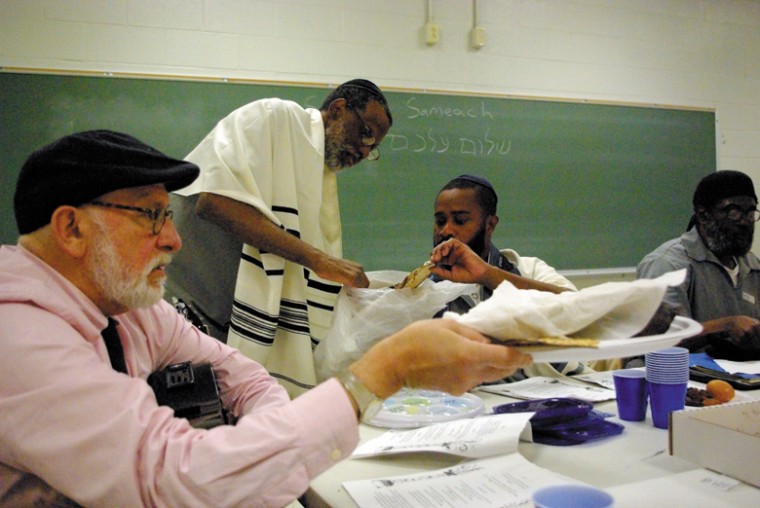Rabbi Goodman: inviting people ‘back into the tent’
Published June 6, 2012
If there is anyone in the St. Louis Jewish community dedicated to those who feel neglected or overlooked, it’s Rabbi James Goodman of Congregation Neve Shalom. For the past three decades, the affable rabbi has helped to spearhead grassroots outreach on behalf of Jews “outside the tent.”
He serves as spiritual leader at Jewish Attention to Mental Illness (JAMI), which he co-founded with virtually no budget. He also helped begin Jewish Prison Outreach. Every month, he visits Missouri prisons to study with Jewish inmates, many of whom battle mental illness and addiction problems.
Goodman understands the connectivity between mental illness and substance abuse. To that end, the Journal of the American Medical Association reports that roughly 50 percent of individuals with severe mental disorders are affected by substance abuse.
“It’s (called) dual diagnosis,” says Dr. Jerold Kreisman, a St. Louis psychiatrist. “(People) with a mental illness may use drugs or alcohol to self-treat or self-medicate to try to reduce their anxiety, depression or anti-social behavior.”
Kresiman says spirituality can help with depression and other mental illnesses because it provides the ability “to look outside one’s self.”
“With any illness, a broken leg or severe depression, it’s hard to remember what it was like to be ‘normal.’ You get kind of self-absorbed,” he says. “If you go to church or synagogue it gets you out of the house, connected to something bigger and encourages social interact.”
It’s that kind of thinking that led Goodman to form Shalvah for those dealing with substance abuse issues. The Thursday night meetings at Neve Shalom incorporate spiritual themes and psychological teaching to help combat addiction issues. Given the overlap, some regulars at Shalvah also attend Ellen Rosenbaum’s Achraiyut group for individuals with mental illness as well as JAMI meetings.
The majority of Shalvah attendees are Jewish. But some, like Maria who is not, come because they appreciate the “warm vibe” and feel welcomed. Like most addiction groups, anonymity is standard practice.
“I came to St. Louis to work with people who were on fire and these people are on fire, they want to live,” says Goodman, who sometimes ends Shalvah with a healing prayer as he strums his guitar.
“They stood at the edge of the precipice so everything is present and alive with them,” he continues. “It’s exciting and dramatic to see these people turn their lives around.”
Soon after Goodman arrived here in 1981, he received a call from Rose Mass, a social worker who specialized in counseling Jews with alcohol and drug issues. “No one was doing this work at the time and (I )felt this would be an area where I could really make a difference,” she says.
Mass had heard about the new rabbi and his desire to reach Jews who lived “between the spaces.” Together they started an alcohol and substance abuse recovery group that met once a month. In 1998, it morphed into Shalvah (meaning “serenity” in Hebrew).
“For the first year, it was just Rose and myself talking to each other,” says Goodman, laughing. “Then, they started coming. It was all through word-of-mouth. When we started advertising, our ad read, ‘It’ll cost you a buck and all you have to do is change your entire life.’”
Goodman estimates that since the early 1980s, more than 1,000 Jews have “come through the door.” Among them is Sid Wasserman, 67, who has been attending since 1985, the year he got sober.
Vowing never to be like his alcoholic father who died at age 58, Wasserman drank his first beer at 20 and was hooked. He began drinking daily, he says, probably because, “I had been severely depressed since I was a teenager but didn’t want to deal with it.”
After alcohol, he turned to marijuana, then heavy narcotics prescribed by a psychiatrist who kept increasing the dosage when Wasserman felt the pills weren’t helping him sleep.
Nearly comatose, he eventually was admitted to Edgewood rehabilitation center followed by two years of outpatient therapy. During that time he started having severe panic attacks, “where I felt my head was going to explode and my chest was caving in.” He was diagnosed with panic disorder and says he still has attacks, though they are much less frequent.
Wasserman met Goodman when the rabbi was seeing patients at Edgewood. The two connected. Goodman’s Shalvah meetings, Wasserman says, have played an integral part in restoring his life.
“I can’t explain it but Jim’s meetings are more from the heart. There’s just something special about them. When you enter the room there is an aura of respect and positivity. I always feel better than when I came.”















